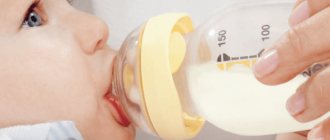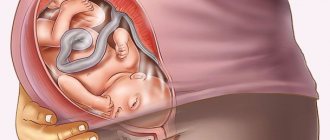Before the baby is born, most women try to learn as much useful information as possible that will be useful in the future. Many of them are interested in the benefits of colostrum, its composition and production process. Therefore, we will talk about this next.
Newborn's first food
Breastfeeding is a natural process, the duration of which new mothers want to prolong as much as possible. After all, along with mother's milk, the newborn receives nutrients that contribute to its development. This process is quite complex and interesting. The body prepares for it from the first weeks of pregnancy.
A baby’s first food after birth is not breast milk, as is commonly believed, but colostrum. It is extremely healthy and nutritious. And it is very important that the newborn receives it in a timely manner, because this allows his body to replenish everything that is necessary for growth, development and health.
What is colostrum
Colostrum is a substance that is secreted from a woman's breasts. It has a liquid consistency, but is quite thick compared to milk. The color of this substance also differs from breast milk - it can be transparent or slightly yellowish.
Most women learn about its production only after the baby is born. But it also happens that this fluid is released from the breast in the last month of pregnancy and even earlier. Why is this happening?
The following factors influence colostrum production:
- At what time was the child born - full-term or premature?
- He was born as a result of natural childbirth or by caesarean section;
- What kind of pregnancy is it?
The peculiarity of the female body also plays an important role here.
After the baby is born, colostrum is produced from the mother's breast for an average of 5 days. Then the usual volume of the substance begins to gradually decrease, because it is replaced by milk, the production of which increases at this time.
The benefits of colostrum for a newborn

Colostrum is the very first food in the life of a newborn, which the mother’s mammary glands begin to produce during pregnancy. The first colostrum is a thick, yellowish secretion with a specific taste and smell. What are the benefits of colostrum ?
Colostrum is a reliable protection for the baby during the period of adaptation to the outside world. It serves as a source of protein, which helps nutrients be well absorbed in the newborn's body. Colostrum produces protective antibodies, such as IgA, IgG, IgM, IgD, which prevent various bacteria and infections from entering the baby’s body. IgA is a good protection for the mucous membranes of the baby’s internal organs, and IgM helps quickly fight pathogenic viruses. These antibodies were developed in the mother’s body and some were passed on to the baby through the placenta, while others would be transferred through colostrum. Interestingly, the nutrient content of colostrum is higher than that of milk.
Colostrum after childbirth comes, although in small quantities, but can satisfy the need for food. For the internal organs of a small child, which are highly susceptible to infection, colostrum is a good protective factor. The newborn's stomach quickly digests the first colostrum , which contributes to the harmonious functioning of the baby's digestive system. Also, colostrum is a good help for the baby’s intestines, because it is this organ that is most susceptible to bacteria and infections. Even in the womb, meconium, the first feces, has formed in the fetus’s intestines. Colostrum will help quickly clear the intestines of meconium, which will help prevent physiological jaundice in newborns, since the baby's first stool contains an excess amount of bilirubin.
Feeding colostrum is a reliable way to protect your baby from unnecessary risks in the first hours of life. It is important to breastfeed your baby more often, because this promotes milk production, which usually comes on the third day after birth, replacing the first colostrum . It has a liquid consistency, so the baby’s time at the breast will increase, since saturation will not be as fast. Frequent feedings will help prevent breast fullness, since more milk comes in than colostrum, and will also ensure that the baby’s body receives the necessary vitamins and elements contained in mother’s milk.
INTERESTING! Compatibility of medications with breastfeeding
No formula can replace mother's milk, which contains the maximum amount of vital vitamins and nutrients for the baby. Breastfeeding is the key to your baby’s health and immunity! And the benefits of colostrum in this matter are invaluable!
When it starts to be produced
As mentioned above, the period of colostrum production may be different for everyone. Experts say that already from the first weeks of pregnancy this process begins to gain momentum. At first, very little of the substance is produced. But with the onset of the third month of pregnancy, the volume of colostrum increases significantly.
At this time, a certain part of women notices the first discharge on their bra. They can be abundant or just a few drops. Not all pregnant women experience early discharge. They overtake most of the fair sex in the last month of pregnancy.
Some women find out that they are pregnant when they release colostrum from their breasts. Sometimes it happens.
What is the value of first colostrum
A few minutes after the baby is born, he is applied to the breast. Mom helps him find his nipple. Having captured it, the baby tries to get its first food. This may not be easy for him. And the mother needs to endure this period, because colostrum is extremely valuable for a newborn.
It contains protein, as well as immune particles. Their intake into the body is necessary to form a certain protection, which will last for almost 6 months. After all, only after reaching the age of six months does the baby develop strong immunity.
What is the value of colostrum:
- It has a positive effect on the formation and further functioning of the gastrointestinal tract. This happens thanks to the protein albumin, which is contained in sufficient quantities;
- Helps improve the process of digesting food;
- Has a laxative effect. Due to this, in the near future after birth, the child’s body gets rid of meconium - original feces. Statistics say that children who were put to the breast after birth and received the first colostrum, in the first days of life, empty their intestines more often than their bladder;
- Makes the immune system invulnerable to many diseases caused by a virus or infection in the nasopharynx and intestines. The protective function is provided by immunoglobulin, which is present in the composition;
- Replenishes the body with vitamins and substances that are necessary for the development and growth of the newborn. These are vitamin A, B, E, ascorbic acid and carotene;
- This is a very nutritious product. Receiving it, the baby’s body is quickly and for a long time saturated. At the same time, it is well absorbed and digested;
- Promotes blood saturation with antioxidant substances;
- Prevents the appearance of jaundice after birth;
- Has a positive effect on the nervous system;
- Babies who received colostrum in the first days of life are less prone to allergies;
- It is a source of necessary hormones and enzymes;
- Contains a minimal amount of fat and sugar.

Both breast milk and colostrum are beneficial for newborns. If you compare them with each other, then colostrum is more nutritious. It contains about 14% protein, which is almost 3 times more than breast milk.
As for the water included in colostrum, there is very little of it. Nature made sure that in the first days after birth, the newborn’s kidneys were not overloaded, processing large volumes of fluid. After all, they have not yet undergone adaptation.
There is no need to worry about dehydration of the child's body. At the time of birth, it contains a sufficient amount of fluid, which will last until the baby begins to receive breast milk.
Composition of colostrum
Colostrum contains:
- Immune bodies, antibodies and antioxidants, which gives protection against all harmful bacteria.
- Leukocytes are protective white cells that destroy pathogenic bacteria and viruses. All anti-infective proteins provide the first immunization against diseases that the baby may encounter after birth.
- Immunoglobulins are proteins that neutralize most infectious pathogens and toxins in our body.
- Immunoglobulin A is an antibody that protects the weakest places in the body, where it is easiest for infections to penetrate - the mucous membranes of the throat, lungs and gastrointestinal tract. When a newborn is first put to the breast, which occurs immediately after birth, the baby sucks out about a teaspoon of colostrum, and this is enough to reduce the risk of developing bacterial infections.
- Transfer factors are unique “immune memory” molecules that teach the child’s body to fight the infections that it will encounter.
- Endorphins are unique physiological substances that protect the body from a wide variety of stress, increase resistance to physical activity and regulate our mood (“joy hormones”).
- Amino acids are the “building blocks” from which proteins themselves are built. Colostrum is rich in the amino acid taurine, which is essential for the development of the brain, heart and muscles.
- Essential vitamins and minerals are essential regulators of all life processes, from individual biochemical reactions to the functioning of entire organs and systems.
- Digestive enzymes that help the immature gastrointestinal system of the newborn cope with digestion, which is extremely important since the growth and development of the child directly depends on the efficiency of nutrient absorption.
- Prebiotics are natural factors that ensure the growth or normalization of intestinal microflora that provides the body
- Beta-casein7 - affects the functions of the central nervous system, helps develop intelligence, emotions, and general mental development. Special nerve growth substances promote the development of the peripheral and central nervous systems. The growth factor in colostrum promotes the development of the baby's immature intestines after birth.
Feeding with colostrum in the first days after birth
After the baby is born, he needs to gain strength that he spent during childbirth. Therefore, after the mandatory procedures - weighing, changing height, etc., the new mother is offered to put the newborn to the breast. It is recommended to do this in the first hour after birth, since it is during this period that the baby’s sucking reflex is activated.
During the first feeding, the newborn should be fed alternately from both breasts. Its duration should be about 40 minutes. You should take into account the fact that the baby is still weak and will not be able to find and grab the nipple on his own. That's why mom should help him.
The newborn should be placed facing you, lightly pressed against the stomach. His head should be at the level of the mother's chest (the nipple is located opposite the baby's nose). With one hand, the mother supports the breast, and when the baby opens his mouth wide, she helps him grab the nipple. During feeding, the sponges should be turned outward and the nose should not be pressed to the chest. In this position, the baby can easily produce milk, and the mother will not feel any discomfort.

The frequency of breastfeeding in the first days after the birth of a baby may vary. Some children require this every hour, others much less often.
Nutritious and necessary in the first days of a child’s life, colostrum can be produced in different volumes. For one woman, 10 milliliters per day will be the norm, and for another, more than 100 milliliters. And this is not an indicator that in the first case the baby will remain hungry. After all, a few grams of colostrum are enough for him to get enough and get everything he needs.
With the onset of 2-3 days after childbirth, many women complain that the baby is becoming capricious and increasingly demands the breast. They explain such changes by insufficient production of colostrum, which is why the baby is malnourished. In some cases, the reason lies precisely in the fact that the child is malnourished, but not always.
It is on days 2–3 after birth that the mother’s body stops producing colostrum in the same volume. By this time, the baby’s sucking reflex becomes most developed, and frequent breastfeeding promotes the production of breast milk. The newborn’s body requires more food, so the number of feedings increases from this period.
Not knowing about this feature of the body, the young mother panics and does not stop thinking about what to feed her baby. Often she can’t think of anything else to offer her but to offer her a mixture. The result of this is the abandonment of the breast in favor of a bottle with a mixture that itself drips into the mouth.
The appearance of colostrum in a pregnant woman
Colostrum during pregnancy is a product of primary lactation, when the breasts prepare for the birth of a child. Usually it occurs in the first 2 days after the birth of the baby, and then this substance is replaced with full milk. Colostrum during pregnancy can appear at different times, at different stages of pregnancy. It may appear in the first weeks after conception, and this is a sign of pregnancy. Why does it flow in some people in the early stages, and in others before childbirth?
Colostrum in pregnant women is formed immediately after conception - the milk ducts of the glands begin to enlarge and grow, and the lobar parts swell. If before pregnancy they looked like small bags, then after conception they grow to the size of a walnut. When pressing in the chest, pain and tension are felt. Sometimes you can see how in the early stages the first drop of the treasured substance emerges from the mammary glands. Such an event is very important for every woman.
What composition
Colostrum during pregnancy may not always be white or yellow. Often this substance is transparent, sticky, and thick. The liquid contains carotenoids, which are responsible for the color of the substance. If during pregnancy the liquid was colorless, then closer to childbirth it should change in consistency and composition, and, accordingly, color form. Composition of the following substances:
- colostrum corpuscles;
- small milk balls;
- leukocytes.
The milk body is formed from fat cells, so the nutritional value of this ingredient is very high. It is fatty, enriched with vitamins, and a few grams are enough for a child in the first days of life to get enough to eat. Fat cells are converted into cytoplasm, leukocytes are neutralized. It is this composition that provides reliable protection to the baby in the first week of life. On the first day after birth, colostrum has a nutritional value of 170 kcal/100 ml, on the second day – 140 kcal/100 ml, and on the third – 90 kcal/100 ml.
After 5-7 days it becomes transitional milk, and then the woman produces normal milk, which the baby needs for the first six months of life.
When does the first milk appear?
The secretion in the mammary glands is controlled by prolactin, the hormone responsible for milk production. The hormone is produced throughout pregnancy, so it is almost impossible to say exactly when colostrum appears during pregnancy. After childbirth, prolactin is released more strongly, but without the help of the mother herself, milk cannot appear. During the first 3 months, lactation is not normalized; milk can be released during feeding, during sleep, while drinking tea, especially if the tea is hot.
A woman must independently express the first drops of milk while still in the maternity hospital so that it arrives in large quantities. Frequent breastfeeding will not help in the early stages. Even if a woman began to secrete colostrum at 3 or 8 months of pregnancy, there is no pathology. This means that there is more prolactin in the blood this month, and less in the next month. The reasons for this can be very different, there is no need to worry about this. But when milk secretion began to be secreted for a long time, closer to childbirth at about the 40th week, it means that the body is actively preparing to meet the baby.
It is highly not recommended to squeeze out liquid in the 40th week. This will provoke a sharp contraction of the uterine muscles, as a result of which labor is possible, and rapid labor.
It is better for women who are still working while pregnant to carry pads with them. Since milk can leak during your lunch break when drinking hot tea, pads will protect you from unpleasant wet spots on your clothes. However, it is not recommended to wear pads in the first 4-8 weeks after birth. This can cause irritation on the skin of the nipples and disrupt the hygiene of this cavity.
Breast hygiene requires special care - a woman must constantly moisten her nipples with colostrum so as not to provoke cracks and micro-wounds. A microbe accumulates in the mammary glands and multiplies in the milk environment.
Some women, before giving birth, have compressed yellowish specks between the nipple parts that look like dead skin. This is colostrum, which is released in such small quantities that it does not have time to flow to the surface.
When is colostrum dangerous for a woman?
Colostrum in non-pregnant women, or colostrum without pregnancy, indicates a disease of the immune system. For some women who have been pregnant and given birth, milk can remain in the body throughout their lives. This is not a pathology, but it is not the norm either. You should consult a doctor. It is also extremely dangerous when it appears with blood during pregnancy or after childbirth. The reasons for this are the high levels of prolactin in the blood. Hyperprolactinemia can lead to neuroendocrine syndromes, subsequently causing mastopathy, milk stagnation, and suppuration of nearby tissues.
Reasons for the appearance of blood - colostrum with blood is considered a sure sign of intraductal papillomavirus. This is an unpleasant disease that leads to infection of the fetus. The sooner the problem is resolved, the greater the chance of the child being born healthy.
Depending on the course of pregnancy and the number of fetuses, women may produce milk at different times. Below is a table of when it is most likely to appear.
| Dates of pregnancy | Singleton | Twins | Triplets | Repeated pregnancies |
| 32 weeks | At 32 weeks of pregnancy, colostrum in the breasts forms in the milk ducts. | At the 32nd week of pregnancy, milk is actively produced in double size. | At 32 weeks of pregnancy, colostrum is produced in the breasts in triple size. | At the 32nd week of pregnancy, milk flows as at the 40th week in a singleton pregnancy. |
| 33 weeks | At 33 weeks the secretion leaks, it is recommended to carry pads with you. | At week 33, milk fills the milk lobes. | At week 33, colostrum fills the milk lobes. | At week 33, colostrum changes color and consistency. Becomes thick and sticky. |
| 36 weeks | The secretion fills the milky lobes of the breast. | During this period, milk begins to leak heavily. To avoid loss, you need to eat dairy products. | This month the milk disappeared, then it appeared again. The color changes every week. | More substance accumulates in one breast than in the other. The color looks like pearlescent pink. |
| 40 weeks | The secret begins to accumulate. This is not yet a sign of imminent labor. It is recommended to wear pads. | The secretion is already being reformed into milk. This is a sign of imminent labor. You cannot pump, otherwise it will lead to rapid labor. It is recommended to wear pads. | At week 40, colostrum begins to flow quickly. It is recommended to wear pads. | In the 40th week, milk is produced as in the 32nd week. This is a sign of imminent labor. This month you can’t squeeze it out, even to see the color. |
Regardless of which trimester milk appears, it should be remembered that this is a harbinger of pregnancy and childbirth. No matter what stage it appears, there is nothing to worry about.
prozhelezu.ru
Why can't you administer the mixture?
If you are faced with the fact that, in your opinion, colostrum is produced significantly less than what the baby needs, do not rush to feed him formula. And the first reason contributing to this is banal insecurity. An incorrectly selected mixture can cost children's health and even life.
Before switching to artificial feeding, you should consult your doctor. He will examine the baby, determine the cause of his anxiety and suggest the correct algorithm of action.
Do not forget that colostrum received in the first minutes after the birth of children replenishes their body with the necessary substances. They protect them from viruses and infections, as well as many other problems discussed above.
And if there is no doubt that colostrum is beneficial for a newborn, then with the mixture things are somewhat different. Having given the baby formula, the mother must understand that he can refuse to breastfeed, since breast milk does not drip into the mouth on its own, like formula from a bottle. And in order to eat, you don’t need to make any effort.
If you reduce the number of breastfeedings, then milk production will decrease every day. This can lead to it disappearing altogether.
And these are not all the consequences that switching to a mixture can bring. By feeding the baby with it at least once a day, changes occur in the intestinal microflora, and there is a high probability of developing dysbacteriosis.
Scientific research only confirms the fact that children need colostrum in the first hours after birth, and not formula.











